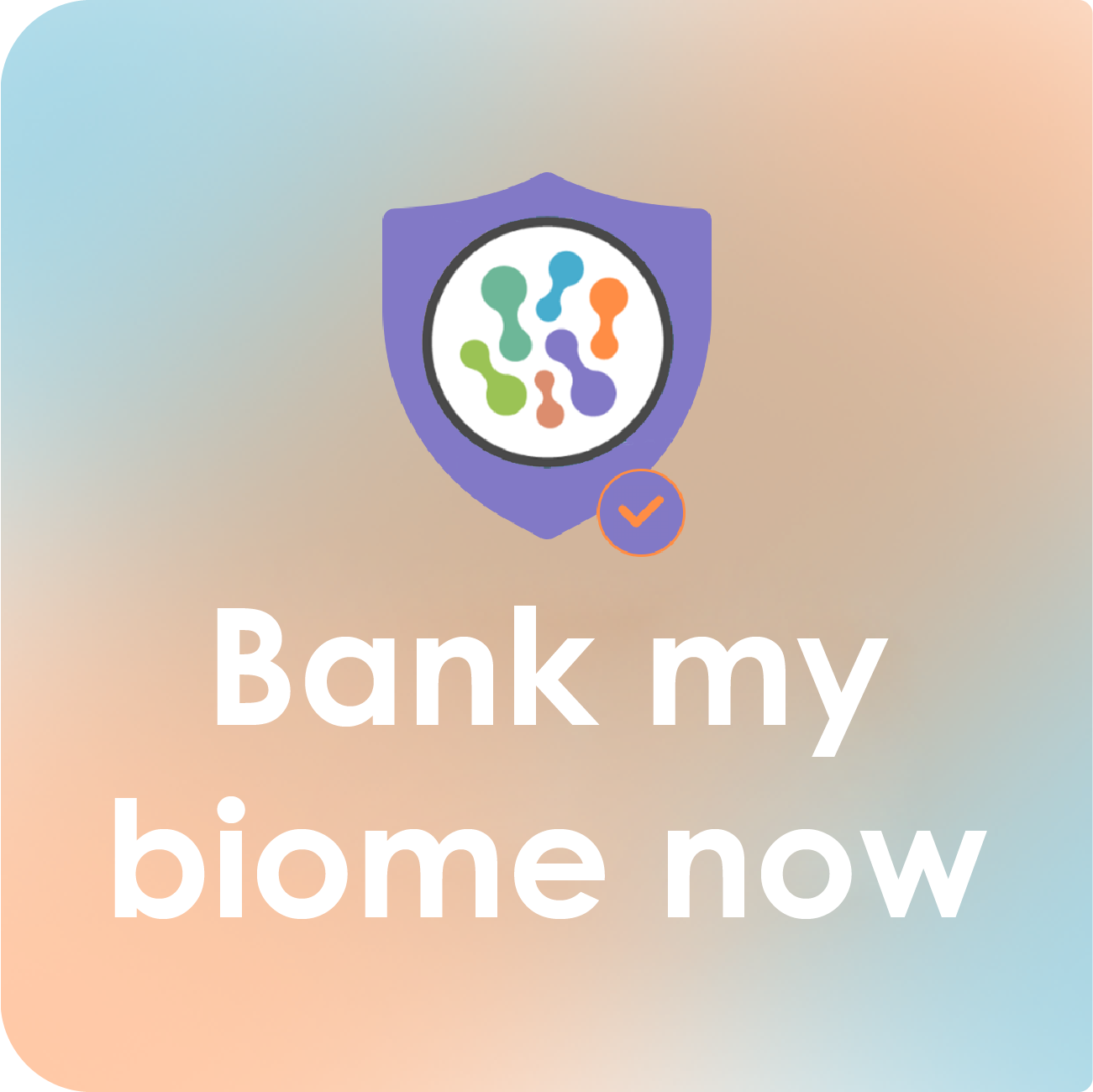Why bank your biome
Invest today, thrive tomorrow – with microbiome banking, your gut-health remains firmly within your control
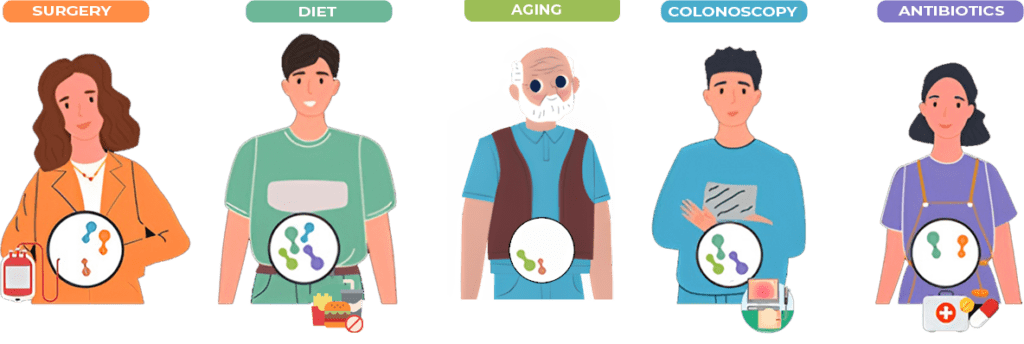
When could having your biome banked be useful?
- Scheduled for a colonoscopy: Some medical procedures can throw off your gut’s microbial harmony, colonoscopies are no different 8-10. By baking your biome, you’re armed with your own health-enhancing biome backup .
- Scheduled for antibiotics: Antibiotics are one of the most widely prescribed medications, but they are also known to wreak havoc on your gut microbiome’s intricate ecosystem 11-16. When antibiotics come knocking, you can be prepared; your banked microbiome has your back.
- Scheduled for surgery: Surgeries, frequently involving antibiotics, can negatively impact the gut microbiome 17-19. Having your microbiome on standby can help to enhance your recovery!
- As you age: As a natural part of aging, the gut microbiome declines 20–28. This decline may be connected to many negative age-associated changes related to immunity, inflammation, frailty, neurodegenerative diseases (i.e. Alzheimer’s disease), and cognitive function 25,27,29–33,33–39. It appears that gut health may play an important role in longevity and overall health and well-being in older adults 26,40–44.
Unlock Better Health for Tomorrow, Today!
When your gut microbiome is stable and healthy, you’re healthy. And when it’s not, you’re not 45-49. Banking your biome allows you to harness your healthy microbiome now and play rewind back to a healthy gut and a healthier you in the future. Your microbiome is unique, and preserving it at its healthiest is an invaluable asset to you and your future health 1,2,50-52! Invest in your health today, bank your biome and arm yourself with a backup to your gut health!
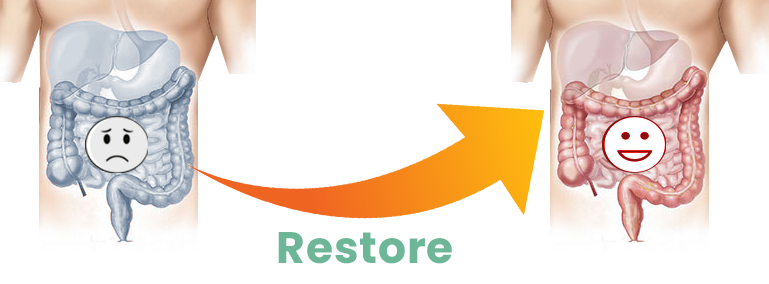
Advantages of Banking Your Biome
Your microbiome: A Superior Alternative to Probiotics
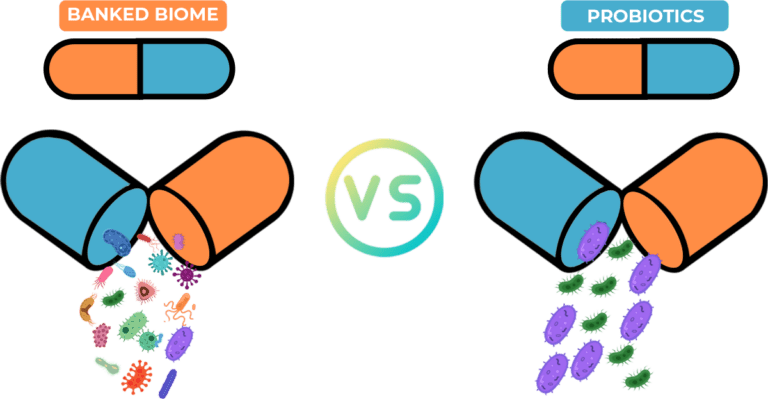
While probiotics and your banked biome might seem similar at first glance, they are pretty distinct in their potential benefits and impacts on gut health. While probiotics can be helpful and have benefits 53-56, their effects are temporary, and probiotics don’t incorporate into the gut microbiome 57-60. On the other hand, your banked biome provides a full spectrum of the microbes in the gut and appears to be more effective in restoring gut microbiome dysfunction 57,59,61-66.
Key differences between probiotics and a banked biome:
- Your banked biome contains the complete spectrum of your microbiome, containing trillions of microbes, whereas probiotics typically only introduce a few bacterial strains 59,61-66.
- Your biome provides full engraftment of your stored microbiome. Research suggests that a full copy of the microbiome is more effective than probiotics in restoring the diversity and richness of the gut microbiome 57,59,66-71.
Antibiotics and gut recovery: Your banked microbiome can help!
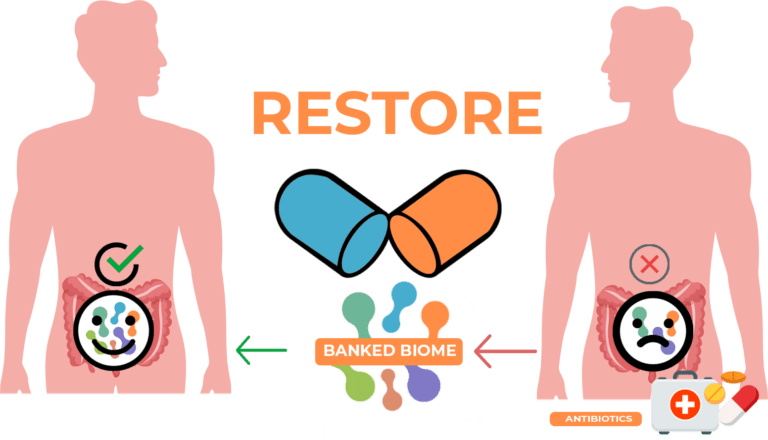
Antibiotics are an incredibly useful tool for treating bacterial infections, but they can have unintended consequences for the gut microbiome 7,11-16, 72-82, potentially having long-term consequences on one’s health, particularly with early-life use 3,11,13,15,16,72,77,78,82-88.
Although the gut microbiome is resilient and can recover from antibiotic exposure, early-life or repeated antibiotic use can make it more difficult for the gut microbiome to recover fully and increase the risk for a range of health problems 16,76,79,81,84,85,89-91.
By banking your biome, you have a healthy copy of your gut microbiome stored, allowing you to harness your healthy microbiome now and play rewind and help restore your gut!
Your Microbiome: Your Optimal Match
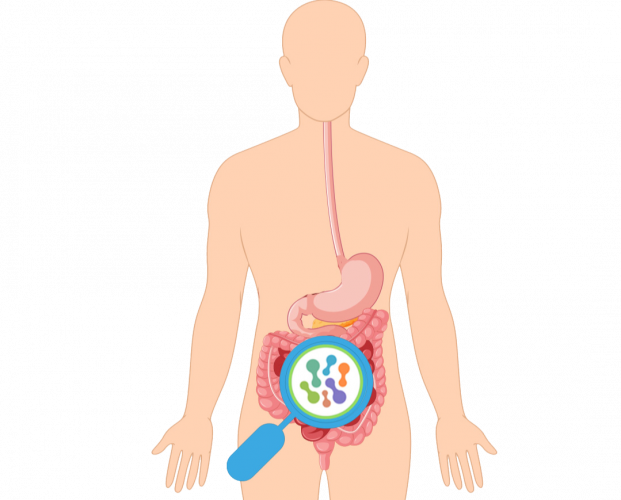
Your microbiome is uniquely you, and preserving it at its healthiest is an invaluable asset to you and your future health 72,92-94. Your banked biome is the best option, ensuring your unique personal attributes, known to impact your gut microbiome, are accounted for 93-102! By banking your biome, you are working with your most ideal donor…..YOU!
What To Expect
- The total time commitment at the treatment location is 5 days, with two of the five days including medically supervised FMT treatment
- 15 weeks of at-home FMT materials, for a total of 16-weeks, will be supplied to you for ongoing treatment
- Guidance on your specific pre-FMT treatment to optimize your child’s gut and overall health so they better respond to the treatment. Nearly always includes antimicrobial or antibiotic treatment with applicable prescriptions made by our physician’s assistant Marie Mvogo.
Once you arrive at the treatment clinic location:
- Day 1 Arrive at treatment location airport + transport to suggested hotel
- Day 2 Medical Consult and Bowel Cleanse
- Day 3 First FMT treatment utilizing enema or capsules for the “loading dose”
- Day 4 Second FMT loading dose treatment
- Day 5 Transport back to the airport for the trip home. Maintenance treatment to start when you arrive back home.
A further 15 weeks of “at home” treatment will accompany you home with the appropriate storage supplies for the remainder of the treatment.
Donor Screening is our #1 Priority
At Novel Biome™, we understand that the most critical safety component of your child’s medically supervised FMT treatment is appropriate and safe donor screening! This is why we make this our #1 priority, ensuring that we manufacture the highest quality product we can in our pharmaceutical-grade lab facility. Our manufacturing process includes extensive donor screening along with appropriate medical assessment and blood and stool testing.
Donor Screening:
We use stringent initial screening criteria exceeding all published screening standards4-13. In addition to extensive laboratory analysis, the donor’s medical background and health history are pivotal in determining whether or not they would make a suitable donor.
A basic screen of their medical history would include the following diseases:
- Chronic infectious disease(s)
- Known exposure to HIV or Viral Hepatitis
- Autoimmune disease(s)
- Gastrointestinal disease or symptoms
- Atopic disease(s)
- Metabolic disorders
- Mood disorders and Neuro-Atypical
- Neurodegenerative Disorder(s)
- Chronic pain syndrome
- Malignancies
- Obesity
We ensure high-quality donors by surpassing screening standards4-13 and only select donors who are vaginally born, breastfed, active, physically fit, no history of neurological, psychiatric or neurodevelopmental disorders, eat a diverse omnivorous diet and have never received antibiotics in their lives, all factors that are known to affect the microbiome14-16.
Novel Biome’s initial donor screening goes above and beyond the standard4-13
| Standard initial medical and health screening4-13 | Novel Biome’s initial screening |
|---|---|
| - | Vaginally born |
| - | Breastfed |
| Donor ages range from ≥18 and ≤60 years old | All donors under 30 years of age |
| General healthy diet | Confirmed diverse omnivorous diet |
| <3 months use of antibiotics, antifungals, antivirals, immune-suppressants, chemotherapy | No lifetime use of antibiotics, antifungals, antivirals, immune-suppressants, chemotherapy |
| - | Never smoked and lives in a non-smoking home (both tobacco and cannabis) |
| Only recent allergic reactions | No allergies |
| No travel of 6 months to tropical countries and high-risk areas of communicable disease/ infectious intestinal diseases | No travel for 12 months outside of home country |
| Inquire about 13 different infectious diseases | Inquire about 34 different infectious diseases |
| - | No treatment or diagnosis for ADHD and ADD |
| - | No sleep issues (e.g. insomnia, frequent waking, nightmares) |
Blood and Stool Testing:
Once a donor has passed our initial screening, we then apply another set of stringent screening, to rule out any possible abnormalities that may be found in blood or stool. . All our donors reside in North America and undergo both initial and routine (every 90 days) screening that includes 120 testing parameters to evaluate blood and stool, including parasites, viruses, fungi, and active infections to ensure all collected and processed materials are safe to be implanted. To best ensure quality and safety, all stool that is processed and manufactured is first held in quarantine for 90 days to ensure all blood and stool screening passes our standards. For additional safety, we keep a portion of all manufactured samples to ensure in the case of an adverse event, we are able to perform additional testing.
- Complete Blood Count (CBC) & Comprehensive Metabolic Panel (CMP)
- HIV, type 1 and 2
- Hepatitis A virus IgM
- Hepatitis B surface antigen
- Hepatitis C virus antibody
- Treponema pallidum (Cascade with reflex to RPR)
- Total of 54 blood tests
Stool testing:
- C difficile toxin B by PCR
- Routine bacterial culture for enteric pathogens
- Ova and parasites
- PCR stool testing for beneficial fecal flora, pathogenic organisms, including bacteria, fungi, and parasites
- Multidrug-Resistant Organisms (MDROs): ESBL, MRSA, VRE
- Total of 73 stool tests
1. Kang et al., 2017, 2. Kang et al., 2019, 3. Moulton et al., 2019, 4. Cammarota et al., 2017, 5. Jørgensen et al., 2017, 6. Australian Regulatory Guidelines of Biologicals., 2020, 7. Cammarota et al., 2019, 8. Mullish et al., 2018, 9. Terveer et al., 2017, 10. Bakken et al., 2011, 11. Kelly et al., 2015, 12. Woodworth et al., 2017, 13. Sokol et al., 2016, 14. Gomaa et al., 2020, 15. Shao et al., 2019, 16. Pannaraj et al., 2017
References: 1. Hall, A. B. et al. 2017, 2. Wilson, B. C. et al. 2019, 3. Choi, H. H. & Cho, Y.-S. 2016, 4. Sommer, F. & Bäckhed, F. 2013, 5. Duvallet, C. et al. 2017, 6. Kriss, M. et al. 2018, 7. Sullivan, Å. et al. 2001, 8. Kim, J. H. et al. 2021, 9. Drago, L. et al. 2016, 10. Drago, L. et al. 2019, 11. Buffie, C. G. & Pamer, E. G. 2013, 12. Chai, G. et al. 2012, 13. Kim, S. et al. 2017, 14. McFarland, L. V. 1998, 15. Modi, S. R. et al. 2014, 16. Vangay, P. et al. 2015, 17. Guyton, K. & Alverdy, J. C. 2017, 18. Serbanescu, M. A. et al. 2019, 19. Stavrou, G. 2016, 20. Askarova, S. et al. 2020, 21. Badal, V. D. et al. 2020, 22. Bana, B. & Cabreiro, F. 2019, 23. Buford, T. W. 2020, 24. Cryan, J. F. et al. 2019, 25. Li, H., Ni, J. & Qing, H. 2021, 26. Nagpal, R. et al. 2018, 27. O’Toole, P. W. & Jeffery, I. B. 2015, 28. Salazar, N. et al. 2017, 29. Bosco, N. & Noti, M. 2021, 30. Claesson, M. J. et al. 2012, 31. Hasavci, D. & Blank, T. 2022, 32. Hohman, L. S. & Osborne, L. C. 2022, 33. Jackson, M. A. et al. 2016, 34. Jiang, C. et al. 2017, 35. Ragonnaud, E. & Biragyn, A. 2021, 36. Sun, Y. et al. 2020, 37. van Tongeren, S. P. et al. 2005, 38. Vogt, N. M. et al. 2017, 39. Zhuang, Z.-Q. et al. 2018, 40. Algilani, S. et al. 2014, 41. Dinan, T. G. & Cryan, J. F. 2017, 42. Fart, F. et al. 2020, 43. Kenyon, C. J. 2010, 44. López-Otín, C. et al. 2013, 45. Bresalier, R. S. & Chapkin, R. S. 2020, 46. Ser, H.-L. et al. 2021, 47. Thaiss, C. A. et al. 2016, 48. Thursby, E. & Juge, N. 2017, 49. Yang, I. et al. 2016, 50. Odamaki, T. et al. 2016, 51. Perez-Muñoz, M. E. et al. 2017, 52. The Human Microbiome Project Consortium. 2012, 53. Kim, S.-K. et al. 2019, 54. Wieërs, G. et al. 2020, 55. Wilkins, T. & Sequoia, J. 2017, 56. Williams, N. T. 2010, 57. Khoruts, A. 2018, 58. Maldonado-Gómez, M. X. et al. 2016, 59. Walter, J. et al. 2018, 60. Zmora, N. et al. 2018, 61. Aggarwala, V. et al. 2021, 62. Bojanova, D. P. & Bordenstein, S. R. 2016, 63. Kang, D.-W. et al. 2019, 64. Li, S. S. et al. 2016, 65. Severyn, C. J. & Bhatt, A. S. 2018, 66. Weingarden, A. et al. 2015, 67. Hamilton, M. J. et al. 2013, 68. Kang, D.-W. et al.2017, 69. Smillie, C. S. et al. 2018, 70. Staley, C. et al. 2017, 71. Suez, J. et al. 2018, 72. Antonopoulos, D. A. et al. 2009, 73. Croswell, A. et al. 2009, 74. De La Cochetière, M. F. et al. 2005, 75. Jernberg, C. et al. 2007, 76. Keeney, K. M. et al. 2014, 77. Lange, K. et al. 2016, 78. Lankelma, J. M. et al. 2017, 79. Lozupone, C. A. et al. 2012, 80. Robinson, C. J. & Young, V. B. 2010, 81. Sommer, M. O. & Dantas, G. 2011, 82. Young, V. B. & Schmidt, T. M. 2004, 83. Dethlefsen, L. et al. 2008, 84. Dethlefsen, L. & Relman, D. A. 2011, 85. Korpela, K. et al. 2016, 86. Ramirez, J. et al. 2020, 87. Wistrom, J. 2001, 88. Britton, R. A. & Young, V. B. 2014, 89. Ainonen, S. et al. 2022, 90. Rashidi, A. et al. 2019, 91. Sommer, F. et al. 2017, 92. Rinott, E. et al. 2021, 93. Bulow, C. et al. 2018, 94. Basson, A. R. et al. 2020, 95. Taur, Y. et al. 2018, 96. Pérez-Matute, P. et al. 2020, 97. Lee, C. H. et al. 2019, 98. Schulz, M. D. et al. 2014, 99. Collins, S. M. et al. 2013, 100. Turnbaugh, P. J. et al. 2009, 101. Fei, N. & Zhao, L. 2013, 102. Vrieze, A. et al. 2012.

